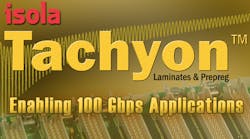Isola Group has begun alpha testing of Tachyon, an ultra-low-loss product engineered to reduce insertion loss in high-speed digital designs. It’s specifically targeted for high-layer-count backplanes for applications with channel data rates exceeding 25 Gbits/s. Tachyon material use spread glass and reduced-profile copper to mitigate skew and improve rise times, lower jitter, and increase eye width and height. Its nominal dielectric constant of 3.02 is stable between −55 and +125°C up to 40 GHz. Dissipation factor shrinks to 0.0021. The materials are available in laminate and prepreg forms in typical thicknesses and standard panel sizes. Their 70-minute curing cycle at 200°C improves press productivity and lowers overall cost. All come standard with very-low-profile copper with 2-µm surface roughness (VLP-2) foil. Isola expect final electrical and thermal field validation and adoption in active designs during the second quarter of this year.

Sponsored Recommendations
Sponsored Recommendations
Wire & Cable Cutting Digi-Spool® Service
April 16, 2024
Connectivity – The Backbone of Sustainable Automation
April 16, 2024
Comments
Comments